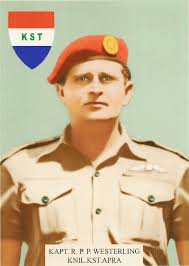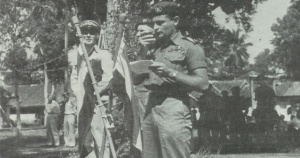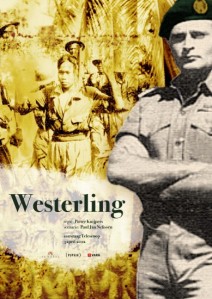
WESTERLING in Indonesia is known as a reference to the assassination of thousands of civilians in South Sulawesi conducted by KNIL (Royal Netherlands East Indies Army) led by Dutch Depot Speciale Troepen commander that named Raymond Pierre Paul Westerling. This incident happened in December 1946 – February 1947 during the counter insurgency military operations.
First Stage: The Military Operation
The first day of Dutch Depot Speciale Troepen (DST) operation begins in the evening on December 11. Primary objective was Batua village and several small villages in the east of Makassar and Raymond Paul Pierre Westerling himself who led the operation. The first troops numbered 58 people, led by Sergeant Major H. Dolkens stormed Borong and DST forces led by Sergeant Major Instructor J. Wolff operates in Batua and Patunorang village. Westerling alongside Sergeant Major Instructor W. Uittenbogaard assisted by two task personnels and one radio operator, meanwhile 10 people were waiting in Batua village to start the raid.
In the first phase, at 04.00 Batua village was surrounded, at 5:45 DSL forces started to search people’s homes. All the people were herded into the center of Batua village. 9 people who tried to escape were immediately shot. After walking several kilometers, at around 8:45 all the people from the villages were collected in the center of Batua village. Westerling reported that the numbers between 3,000 to 4,000 people, women and children were separated from the men.
In the second phase, Dutch Depot Speciale Troepen (DST) forces that led by Raymond Pierre Paul Westerling started to look for the Islamists, rebels, robbers, criminals and murderers. Westerling himself in charge of this action and talk to the people, which translated into Bugis language. He has a list of the Islamist and rebel names which have been compiled by Vermeulen. Heads of village and tribe helps him to identify the name. The result was 35 people accused and directly executed on the spot. This Westerling method was known as the “Standrecht (the court and execution)” on the spot. Then Westerling said in its report that he had sentenced 11 Islamists, 23 robbers and a murderer.In the third phase, Dutch Depot Speciale Troepen (DST) declare that the replacement of the head of village and the formation of rural policy should be subject to Dutch decisions, then all people were told to return to their villages. Operation that started from 04.00 to 12.30 had claimed 44 lives. With the same Westerling sweeping style, the massacre of the people continues in South Sulawesi. Westerling also leads his own operations in Tanjung Bunga village in night of December 12 – 13, 1946. 61 people were allegedly as Islamists shot dead. Besides that, houses in several small villages around Tanjung Bunga village have been set on fire and the numbers of death has reached 81 people.
Next in the evening of December 14 – 15, it was the turn of Kalukuang village located on the outskirts of Makassar city, 23 people were shot dead. According to their intelligence reports, Wolter Monginsidi and Ali Malakka those who hunted by Dutch Depot Speciale Troepen (DST) forces in this region, could not be found. On the night of December 16 – 17, Jongaya village which situated in the southeast of Makassar became the next target, 33 people were executed in this village alone.
Second Stage: The Elimination Of Indonesian Resistance Fighters In Makassar
After cleaning the area around Makassar, the second stage of the action began on December 19, 1946 in Polobangkeng which located in the south of Makassar. According to the Dutch Depot Speciale Troepen (DST) intelligence reports, there are approximately 150 military troops and about 100 members of the armed irregulars.
In this operation, DST with 11 platoons of The Royal Netherlands East Indies Army (Koninklijk Nederlands Indisch Leger; KNIL) Infantry Forces XVII, led by Lt. Col. KNIL Veenendaal raids Renaja and Ko’mara village, while the others were focussed to raid Polobangkeng village. Furthermore, in this operation 330 people were killed.
Third Stage: The Cleansing Of Islamist
The third stage began on December 26, 1946 against Gowa region and conducted in three waves, December 26 – 29 and January 3, 1947. For the sake of greater flexibility for Raymond Pierre Paul Westerling in Sulawesi. On January 6, 1947, General Simon Spoor imposed “noodtoestand” (state of emergency) in South Sulawesi. The massacre of the people conducted by DST and KNIL moved on in many places, Westerling who was leading the operation, gunning down those all who accused of being Islamists.
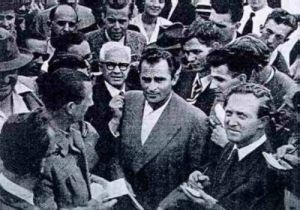 After that, there were still ongoing massacre in some villages and areas that subjected to operation zone of DST forces on February 7 – 14 in the coastal Tanete Riattang, Bone, meanwhile on February 16 -17, Taraweang and Bornong-Bornong village have become the operation zone as well. In Mandar village alone reported 364 residents were killed. The cleansing of “Islamists” escalates in Kulo, Amparita and Maroangin where 171 people were killed.
After that, there were still ongoing massacre in some villages and areas that subjected to operation zone of DST forces on February 7 – 14 in the coastal Tanete Riattang, Bone, meanwhile on February 16 -17, Taraweang and Bornong-Bornong village have become the operation zone as well. In Mandar village alone reported 364 residents were killed. The cleansing of “Islamists” escalates in Kulo, Amparita and Maroangin where 171 people were killed.
General Spoor assumed that the state of emergency in South Sulawesi have been overcome, then on February 21, 1947, he reinstated “Voorschrift voor de uitoefening van de Politiek-Politionele Taak van het Leger – VPTL (Guidelines for Dutch army and police in the field of political)”, and DST troops pulled back to Java.
With the success to crush the Islamists in Sulawesi, Westerling had been praised by the Dutch military and civilians, his reputation as Special Forces commander has been considered having good career. DST camp then moved to Kalibata, then transferred to Batujajar near Cimahi. Westerling holds larger armies, more powerful and gained the rank of Captain.
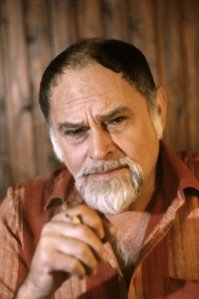 Thousands of people in South Sulawesi who became victims of DST operation remains unclear until now. In 1947, a delegation of the Republic of Indonesia told the UN Security Council, number of victims during the massacre conducted by Raymond Westerling since December 1946 in South Sulawesi reached 40,000 people. While the examination of Dutch government in 1969 estimated, about 3,000 people had been killed by DST Special Forces, while Westerling himself says, that the numbers of the victim killed by his troops only 600 people.
Thousands of people in South Sulawesi who became victims of DST operation remains unclear until now. In 1947, a delegation of the Republic of Indonesia told the UN Security Council, number of victims during the massacre conducted by Raymond Westerling since December 1946 in South Sulawesi reached 40,000 people. While the examination of Dutch government in 1969 estimated, about 3,000 people had been killed by DST Special Forces, while Westerling himself says, that the numbers of the victim killed by his troops only 600 people.
The Massacre By Westerling In South Sulawesi Was Approved
The acts of Westerling and his forces could escape from the demands of human rights violations, because the actual terror acts that conducted by Westerling had obtained a permission from Lt. Gen. Spoor and Deputy Governor General Dr. Hubertus Johannes van Mook. So who will actually responsible for the massacre in South Sulawesi was the Dutch Government and their military.
The massacre conducted by Dutch army in South Sulawesi can be put in the category of crimes against humanity, which even now can be brought to an international court, because the genocide or crimes against humanity, there is no expiration for that. According to Director of Cabinet P.J. Koets which also confirmed by Idenburg, in the meeting, Dutch Government decided not to legitimize the slaughter with Westerling method, despite the action Westerling did, gets approval from all high officials.
In a later memorandum, Attorney General Felderhof writes that the Westerling method was “allowed in a precarious situation, which can force the implementation of the court and execution without process of law”.
Centre for Information and Analysis (CIA)
Wed, 8 Oct 2014

